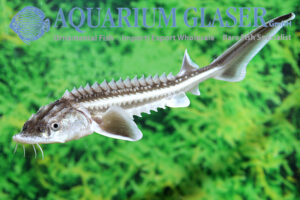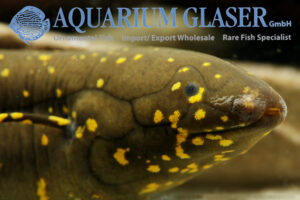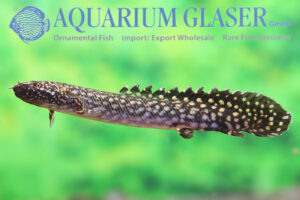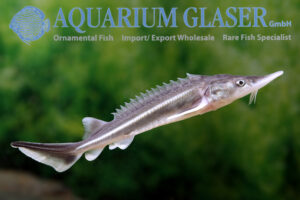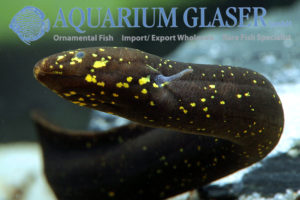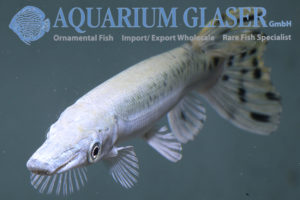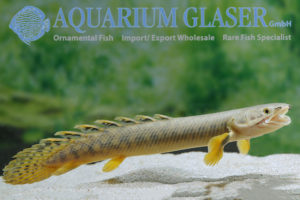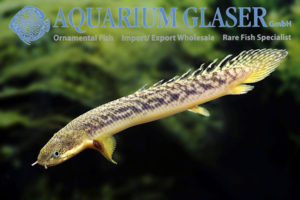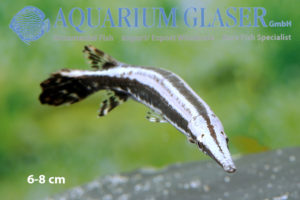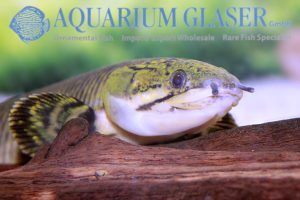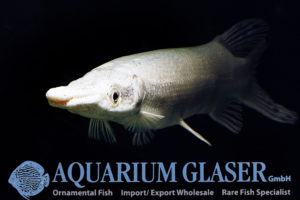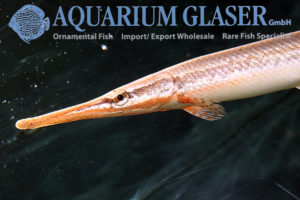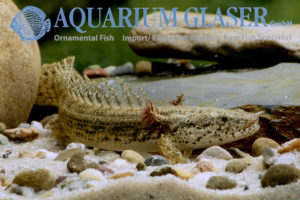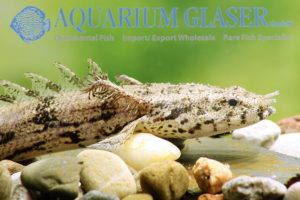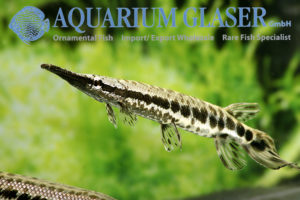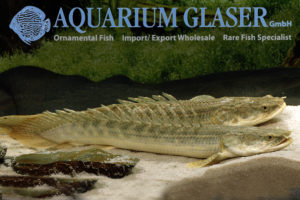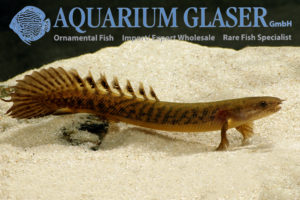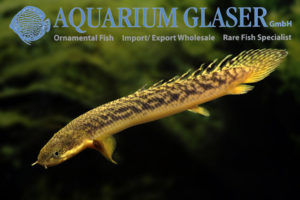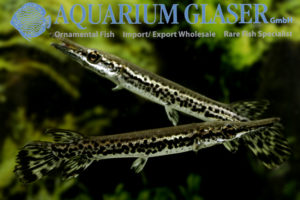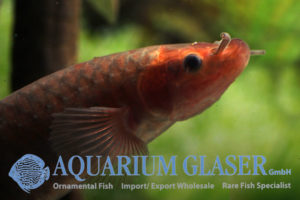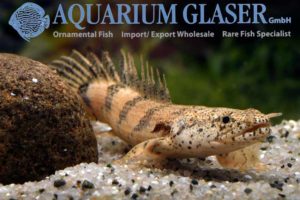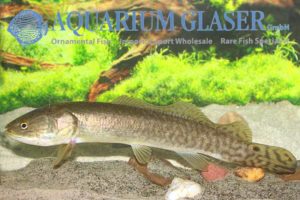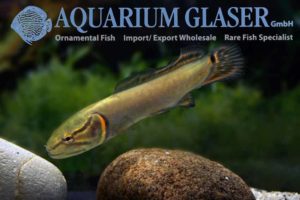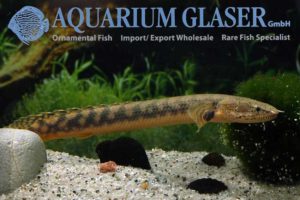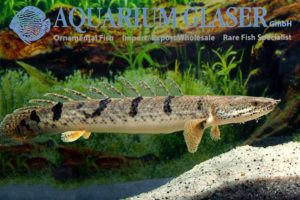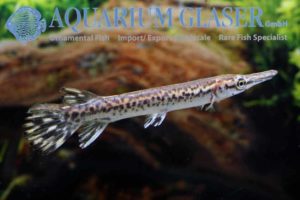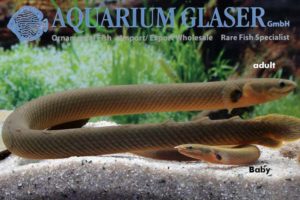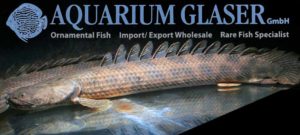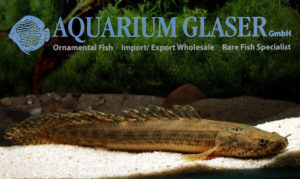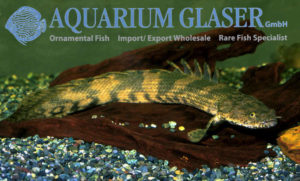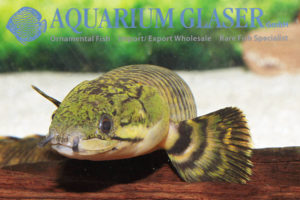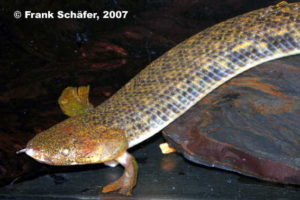Sturgeons are fascinating, ancient fish that have lived on earth for around 200 million years. Unfortunately, almost all species are threatened with extinction in the wild; the main reason is – as always – habitat destruction. As sturgeons have a complex migratory behavior and most species live partly in the sea and partly in fresh […]
02. Living fossils (32)
-
-
Lepidosiren paradoxus 15-18 cm
We have already reported twice on the South American lungfish (Lepidosiren paradoxus), on juveniles here: https://www.aquariumglaser.de/en/02-living-fossils/lepidosiren-paradoxus-4/ and on the adult here: https://www.aquariumglaser.de/en/29-lungfishes/lepidosiren_paradoxus_en/; in both posts you will find further information. This species, which is widespread throughout South America, is a real rarity in the trade. We have just received some medium-sized specimens (8-10 cm and […]
-
Polypterus ornatipinnis
Polypterus ornatipinnis is the most beautifully colored bichir. This species is native to the Congo and grows to over 60 cm in length. Nowadays, however, almost exclusively offspring from Indonesia are on the market. Despite the impressive size that Polypterus ornatipinnis can theoretically reach, this species was the first that could be bred by hobby […]
-
Acipenser ruthenus
The sterlet, Acipenser ruthenus, is one of the smallest sturgeon species. Nevertheless, this fish can also grow to over one meter in length. The largest known specimen is reported to be 125 cm long. Sterlets become usually around 60 cm long. Like all sturgeons, this species is highly endangered due to overfishing and, above all, […]
-
Lepidosiren paradoxus
The South American Lungfish is a very interesting fish, but it has only very drab colours. The usual pattern is mudcolour, eg brownish, greyish, sometimes a bit blackish. But why should an animal that lives in swamps and feeds on snails show bright coloration? On the other hand: astonishingly enough, very young specimens, like the […]
-
Atractosteus spatula “Platinum“
At the moment we can offer several of the precious and rare Platinum animals of the caiman fish. All have the glistening white body ground coloration. Individually different black speckles are present on the currently 12-15 cm long juveniles. These rarities are bred in Indonesia. They are intelligent fish, which come in expectation of food […]
-
Polypterus polli
For many years this small bichir from the Congo did not come to us. Now we finally succeeded in importing them again. Polypterus polli remains under 30 cm total length and thus belongs to the smallest species of these ancient fishes. It can easily be confused with P. palmas from Guinea and with P. retropinnis, […]
-
Polypterus palmas
We received once more from Guinea the comparatively small (20-25 cm) and very pretty Polypterus palmas. Currently our fish are 10-12 cm long. Formerly the species has been splitted in several subspecies, but this seems not to reflect the real situation. For our customers: P. palmas has code 164502 on our stocklist. Please note that […]
-
Lepisosteus oculatus “Metallic“
We have already reported about the Spotted Gar (Lepisosteus oculatus), see https://www.aquariumglaser.de/en/fish-archives/lepisosteus-oculatus-2/. Now we have received small gars from Indonesia, which correspond in all characteristics to L. oculatus, but show a very striking silver luster. The smaller ones (6-8 cm) have a quite dark basic coloration, which brightens up clearly with somewhat larger animals (11-14 […]
-
Polypterus mokelembembe
Bichirs are so called living fossils. Already 60 million years old fossils were found, which can still be assigned to living species today. However, there are only 16 known species, all coming from Africa. The last discovered and at the same time smallest species of the genus is Polypterus mokelembembe, which was described as a […]
-
Atractosteus spatula
The Alligator gars are so-called living fossils. They developed about 100 million years ago in the upper Cretaceous and haven´t changed much since then. Currently two genera live in the New World, namely Atractosteus (containing three species) and Lepisosteus (four species). The members of Atractosteus can reach about 2 m in length (formerly they are […]
-
Red Gars
From Indonesia we have received captive bred specimens of a gar species, which stands out due to its reddish brown (normally blackish, gray or silver) basic coloration with partly brick-red coloration parts. Unfortunately, it is not possible for us to name the species correctly, because the reliable identification of gar is only possible on the […]
-
Polypterus ansorgii
Polypterus ansorgii is perhaps the rarest of the bichirs and also comes from regions in Africa from which ornamental fish exports are rarely possible for political reasons. We have already occasionally reported on this interesting, large-growing species (https://www.aquariumglaser.de/en/fish-archives/polypterus-ansorgii/ and https://www.aquariumglaser.de/en/fish-archives/polypterus_ansorgii_xxl_en/) and a detailed report on P. ansorgii can be found here: https://www.aqualog.de/blog/ansorges-floesselhecht-ein-mythos-wird-entschleiert/ (sadly in German […]
-
Polypterus endlicherii bred (2)
For some time now we have been able to offer offspring of this big bichir (see https://www.aquariumglaser.de/fischarchiv/polypterus_endlicherii_nachzuchten_en/). With the current delivery we noticed the bizarre outer gills, which have young animals of all Polypterus species. They give these primeval fishes a very peculiar appearance. For our customers: the animals have code 163312 on our stocklist. […]
-
Lepisosteus oculatus
The Spotted Gar (Lepisosteus oculatus) is a living fossil. Gars live on earth since about 145 million years. Nowadays 7 species still exist, all native to North- and Central America. Gars are predators. They can survive in oxygen-poor waters due a primitive lung that enables them to breath air additionally to the gill breathing. So […]
-
Polypterus lapradei
Napoleon Bonaparte was leader of a campaign through Egypt in the years 1798-1801. He was followed by 169 scientists, among them the zoologist Étienne Geoffroy Saint-Hilaire. After the return to France, Saint-Hilaire described a very strange species of fish he collected in the Nile river in Egypt under the (vernacular) name of Polyptère bichir. The […]
-
Polypterus teugelsi Bred
The Cross river in Western Africa is a legendary river. The course of the river starts in Cameroon, the lower part flows through Nigeria. The river is famous for its high degree of endemic species; „endemic“ means that the species occurs only there and nowhere else. Among the endemic species are for example Tetraodon pustulatus […]
-
Polypterus palmas
We received once more from Guinea the comparatively small (20-25 cm) and very pretty Polypterus palmas. Currently our fish are 10-12 cm long. Formerly the species has been splitted in several subspecies, but this seems not to reflect the real situation. Two of these subspecies have been recorded from Guinea, namely P. p. palmas and […]
-
Atractosteus spatula
The Alligator gars are so-called living fossils. They developed about 100 million years ago in the upper Cretaceous and haven´t changed much since then. Currently two genera live in the New World, namely Atractosteus (containing three species) and Lepisosteus (four species). The members of Atractosteus can reach about 2 m in length (formerly they are […]
-
Phractolaemus ansorgii
Finally we were able to import again Phractolaemus ansorgii. The last importation was years ago. Sadly the fish are sold out already, but we nevertheless want to show you the interesting animals. Formerly we obtained these fish from Nigeria, this time they originate from the Congo. In our current import obviously two colour morphs appear, […]
-
Polypterus endlicherii bred
This large species – sexual maturity is reached at about 40 cm length, but the species can grow as big as 70 cm – originates from Africa. Her it has a fairly wide distribution, from the Nile to the Niger. But it is difficult to catch, so the fish were rather high in prize. Now […]
-
Amia calva
Four specimens – gorgeous animals, which are 15 – 20 cm long – of this “living fossil” reached us recently. Once there was a time when relatives of this species lived allmost all over the World, even in Europe several species existed. These creatures were already existent when the dinosaurs walked around. However, nowadays only […]
-
Amia calva
Finally – we tried many years without any success – we managed to import a good number of this “living fossil” from the USA. Once there was a time when relatives of this species lived allmost all over the World, even in Europe several species existed. These creatures were already existent when the dinosaurs walked […]
-
Polypterus retropinnis
After quite a long time we were able now to import again one of the smallest species of Polypterus, namely Polypterus retropinnis from the Congo. This bichir has been thought to represent an undescribed species for a while, but then it was found that it has been confused with the only recently described species Polypterus […]
-
Polypterus delhezi
The bichir fishes – Polypterus – are animals of ancient ages. They already existed 60 million years ago. Among the particularities of the bichirs belongs the fact that they breath with a lung and that the pectoral fins are placed at the end of muscular stalks that can be moved like little arms. Some species […]
-
Atractosteus tristoechus
The Alligator gars are so-called living fossils. They developed about 100 million years ago in the upper Cretaceous and haven´t changed much since then. Currently two genera live in the New World, namely Atractosteus (containing three species) and Lepisosteus (four species). The members of Atractosteus can reach about 2 m in length (formerly they are […]
-
Baby reedfish arrived
Only once per year we obtain baby specimens of the reedfish. Now is the season for the charming animals. For our customers: the fish have code 128700 on our stocklist. Please note that we exclusively supply the wholesale trade. Text & photos: Frank Schäfer
-
Polypterus ansorgii xxl
We obtained impressive, 50-60 cm long specimens of this rarest of all species of Polypterus. The fish originate from Guinea. For our customers: the animals have code 162409 on our stocklist. Please note that we exclusively supply the wholesale trade. Text & photo: Frank Schäfer
-
Polypterus ansorgii
We received only two specimens of this bichir – the rarest of all bichir species. The currently imported specimens are 15-20 cm long. The species can reach a maximum length of about 80 cm and thus represents the largest of all known Polypterus species. There appeared a German article on the species in the current […]
-
Polypterus endlicherii GOLD
This large species – sexual maturity is reached at about 40 cm length, but the species can grow as big as 70 cm – is represented in Guinea by a very attractive colour variety that has a yellow-golden basic coloration (vs. ash-grey in others). For our customers: the fish have code 163215 on our stocklist. […]
-
Polypterus mokelembembe
Bichirs are so-called living fossils. 60 million years old fossilizations are known which can be assigned to recent species! There are 16 recent species known so far, all of them originating from Africa. The latest discovered species is also the smallest one: Polypterus mokelembembe was described in 2006. Formely the species was confused with P. […]
-
Polypterus teugelsi
From the Cross River system in Cameroon originates Polypterus teugelsi. This 2004 scientifically described species could be imported in this spring for the first time. They exhibit a black network, which covers an olive background on the dorsal and dorsolateral surface of the body. This and their brightly orange colored belly are singular in bichirs. […]





